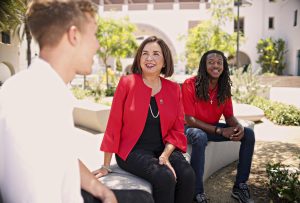Thanks to a donation by Lightworks Editing Systems, the San Diego State University film and video editing department received a $120,000 piece of computerized editing equipment last week.
One of the most important functions of the system is to eliminate physical contact with film. Instead of laying frames out and editing them by hand, everything is done by computer.
The system at SDSU runs off a Macintosh computer. Sounds, colors, pictures and words are shown on the computer screen and can be moved and edited simply by dragging them in the appropriate positions with a mouse.
This system, which is called digital nonlinear editing, is what the major New York and Los Angeles film companies use, said Professor Jack Ofield of the School of Communication.
“When students graduate they will already be familiar with this equipment,” Ofield said.
The system is also useful because it aligns the time frames of video to that of film. On old systems the editor would have to account for the lapse in frame speed by hand.
With the old system of editing, students can spend more than a year editing a single film. This system cuts that amount of time down to a couple of weeks, said Professor Tom Medir, also of the School of Communication, who played a major role in getting the donation.
These time-saving processes have a direct effect on the amount of creativity students have in editing film.
“This system allows you to make as many cuts as you want without damaging the film,” said James Ray, an engineer in the film and telecommunications department. “This allows a lot more artistic freedom.”
As part of the deal, both Ray and Ofield had to attend a weeklong training session in Los Angeles to understand how to use the system.
The cost of the training was provided free by Lightworks, and their expenses were paid for by the College of Professional Studies and Fine Arts.
The system isn’t very difficult for students to learn because they are used to using computers for everything else, Ofield said.
“It’s sometimes harder for some of the professors and faculty members to pick it up,” he said. “We’re used to editing the old way.”
The digital system will be used at this point by seniors only simply because SDSU doesn’t have the funding to provide usage to all students, Medir said. The cost to lease this kind of system would run about $2,000 per week.
Discussions with Lightworks have been ongoing since last May, said Medir, who heard about the possibility of donation through a friend at Paramount Pictures.
Lightworks donated the equipment because it constantly updated its editing systems.
“We’re only about three years behind state-of-the-art editing equipment,” Medir said. “It’s absolutely amazing.”
It’s also advantageous for Lightworks to have students entering the work force who are familiar with their system.
“Students who are interested in a career in editing will walk out of here with firsthand experience,” Medir said. “This will make them very attractive to employers.”
The University of California San Diego, University of San Diego, University of California Los Angeles, University of Southern California and the University of Nevada-Las Vegas also received similar donations from Lightworks.
Medir is working with the company to try to get two or three more nonlinear digital editing systems for SDSU.









